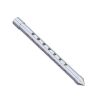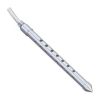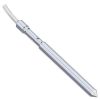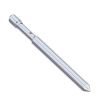Solinst Model 615 Drive-Point Piezometer
Features
- Affordable method to monitor shallow groundwater and soil vapor
- Attach to inexpensive 3/4" (20 mm) NPT steel drive pipe
- Can be used for permanent well points or short-term monitoring applications
- Expedited repair and warranty service
- Lifetime technical support
- More
Overview
The Solinst Model 615 Drive-Point Piezometer uses a high quality stainless steel piezometer tip, 3/4" NPT pipe for drive extensions and LDPE or Teflon sample tubing, if desired. Combine these with an inexpensive Slide Hammer and you have a complete system.
Design
The Solinst Model 615 Drive-Point Piezometer has a stainless steel, 50 mesh cylindrical filter-screen, within a 3/4" (20 mm) stainless steel drive-point body, screen support and a barbed fitting for attachment of sample tubing. Optional heavy-duty extension couplings are also available to create a strengthened and more rugged piezometer.
The inner barbed fitting allows connection of 5/8" OD x 1/2" ID (16 mm x 12 mm) LDPE or Teflon sample tubing. This prevents sample water from contacting the steel extension rods, and maintains high sample integrity, even when inexpensive carbon steel extensions are used.
In The News
New map shows significant groundwater depletion in Central California
Groundwater level data collected by a Central California county shows significant drops during the past 12 years, according to a San Luis Obispo Tribune article. Data shows that groundwater has dropped by a minimum of 70 feet from 1997 to 2009 in the Paso Robles area of Central California. In the past four years the areas of most significant decline have expanded north and south. Drought and agricultural withdrawals are the likely culprits for the groundwater decline. Some advocates are calling for more responsible water use by vineyards in the area, while farmers note that the recent drought did not help the situation.
Read MoreCombating Water Insecurity in Saskatchewan with Real-Time Data
The prairies of Saskatchewan can be described as one of the least water-secure parts of Canada, making water quality monitoring essential for informed resource management in a region already facing water insecurity. While natural physical properties worsen some of the poor water quality conditions in the region, others are connected to land use. Having grown up spending summers on the shores of Lake Huron, Helen Baulch, an associate professor at the School of Environment and Sustainability at the University of Saskatchewan , has always been dedicated to the protection of water resources. Looking back fondly at her childhood playing along the shore, Baulch also recalls the invasion of quagga mussels during her teenage years and watching the lake change as a result.
Read MoreSeametrics Turbo Turbidity Logger: Boost your Turbidity Monitoring
The Seametrics Turbo Turbidity Logger is a self-cleaning turbidity sensor capable of internally logging over 260,000 data records. The sensor enables researchers, compliance officers, and contractors to monitor turbidity in various applications, from construction and dredging sites to wastewater effluent. Due to its narrow width, this device can be deployed in a range of areas, from small well spaces to rivers and streams. The stainless steel housing and built-in wiper allow the sensor to withstand long-term deployments and reduce the need for maintenance trips. The logger accurately records temperature and turbidity up to a depth of 50 meters.
Read More















